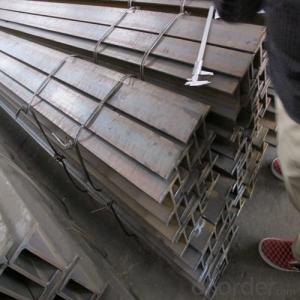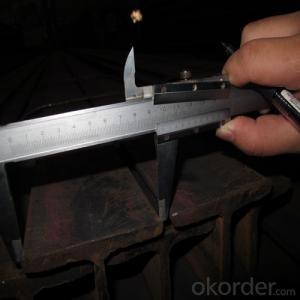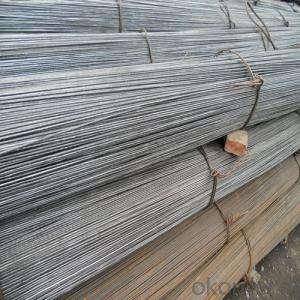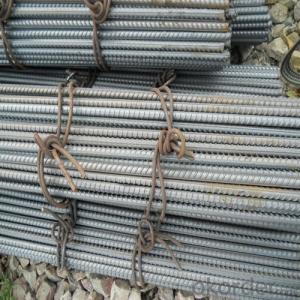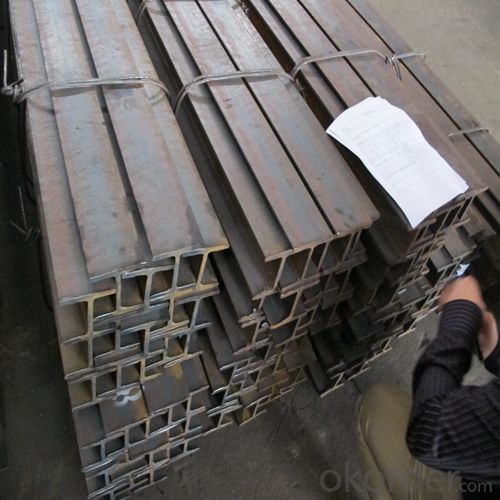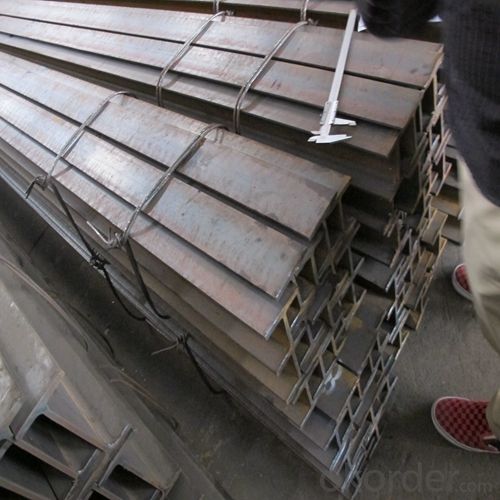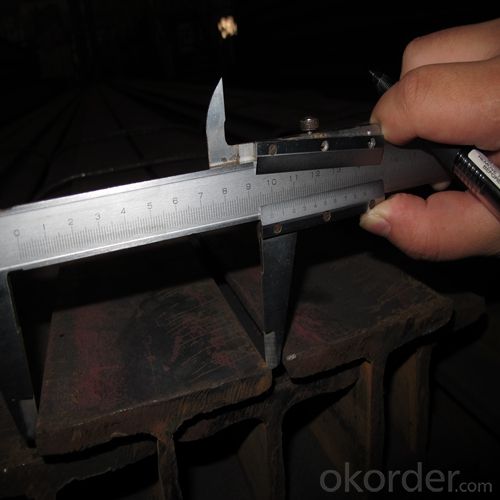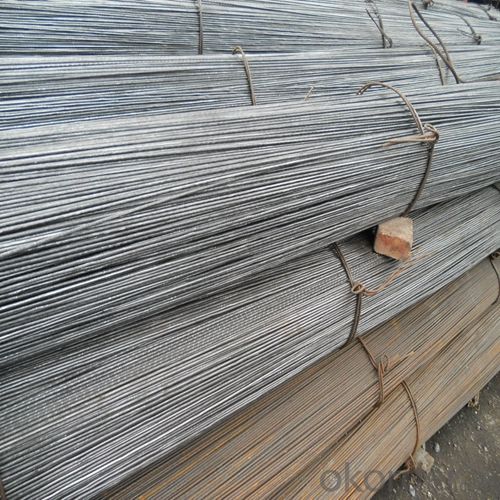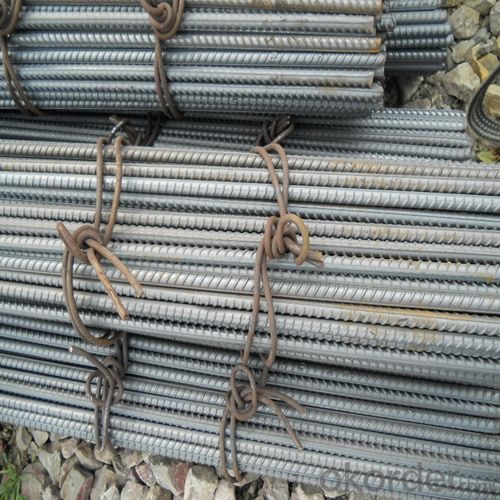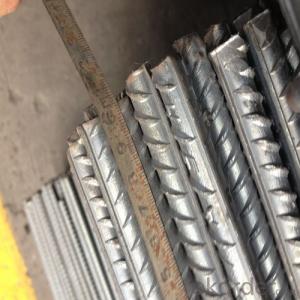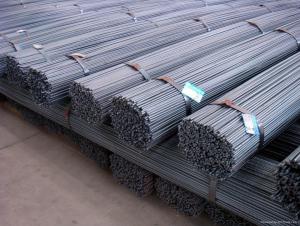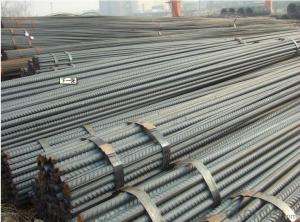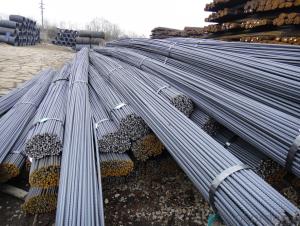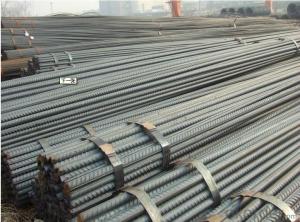Deformed Steel Bar Hot Rolled HRB4000 HRB500 ASTM A615 GR40/GR60
- Loading Port:
- Tianjin
- Payment Terms:
- TT OR LC
- Min Order Qty:
- 500 m.t.
- Supply Capability:
- 30000 m.t./month
OKorder Service Pledge
OKorder Financial Service
You Might Also Like
Product Description:
Specifications of HRB500 Deformed Steel Bar:
Standard | GB | HRB500 |
Diameter | 6mm,8mm,10mm,12mm,14mm,16mm,18mm,20mm, 22mm,25mm,28mm,32mm,36mm,40mm,50mm | |
Length | 6M, 9M,12M or as required | |
Payment term | TT or L/C | |
Application | mainly used in construction industry to reinforce concrete structures and so on | |
Quality | First quality, the goods are from Chinese big manufacturers. | |
Type | Hot rolled deformed steel bar | |
Brand name | DRAGON | |
Chemical Composition: (Please kindly find our chemistry of our material based on HRB500 as below for your information)
Grade | Technical data of the original chemical composition (%) | ||||||
C | Mn | Si | S | P | V | ||
HRB500 | ≤0.25 | ≤1.60 | ≤0.80 | ≤0.045 | ≤0.045 | 0.08-0.12 | |
Physical capability | |||||||
Yield Strength (N/cm²) | Tensile Strength (N/cm²) | Elongation (%) | |||||
≥500 | ≥630 | ≥12 | |||||
Theoretical weight and section area of each diameter as below for your information:
Diameter(mm) | Section area (mm²) | Mass(kg/m) | Weight of 12m bar(kg) |
6 | 28.27 | 0.222 | 2.664 |
8 | 50.27 | 0.395 | 4.74 |
10 | 78.54 | 0.617 | 7.404 |
12 | 113.1 | 0.888 | 10.656 |
14 | 153.9 | 1.21 | 14.52 |
16 | 201.1 | 1.58 | 18.96 |
18 | 254.5 | 2.00 | 24 |
20 | 314.2 | 2.47 | 29.64 |
22 | 380.1 | 2.98 | 35.76 |
25 | 490.9 | 3.85 | 46.2 |
28 | 615.8 | 4.83 | 57.96 |
32 | 804.2 | 6.31 | 75.72 |
36 | 1018 | 7.99 | 98.88 |
40 | 1257 | 9.87 | 118.44 |
50 | 1964 | 15.42 | 185.04 |
Usage and Applications of HRB500 Deformed Steel Bar:
Deformed bar is widely used in buildings, bridges, roads and other engineering construction. Big to highways, railways, bridges, culverts, tunnels, public facilities such as flood control, dam, small to housing construction, beam, column, wall and the foundation of the plate, deformed bar is an integral structure material. With the development of world economy and the vigorous development of infrastructure construction, real estate, the demand for deformed bar will be larger and larger..
Product Description:
Quick Details
Standard:ASTM, BS, GB, JIS
Grade:HRB335
Diameter:6-50mm
Length:6-12m
Place of Origin:Tianjin, China (Mainland)
Application:construction
Deformed Steel Bar:Original Tianjin China
Standard1:BS4449
Standard2:ASTM A615
Standard3:GB/T1449
Grade1:HRB335
Grade2:HRB400
Grade3:HRB500
Grade4:460B
Grade5:GR.40
Grade6:GR.60
Packaging & Delivery
| Packaging Details: | with bundle and bare packing |
|---|---|
| Delivery Detail: | within 15-20days |
Specifications
Deformed Steel Bar
1).Standard:BS4449 ASTM A 615
2).Grade:HRB335/400/500,460B,GR40/60
3) Experience : 5years for exporting
| Tianjin Baolf Steel Co.,Limited | |
| Standard | BS4449 ASTM A615 GB/T1499 |
| Grade | HRB335/400/500,460B,GR40/60 |
| Diameter | 6-50mm |
| Length | 6,9,12m |
| Technique | Hot Rolled |
| Application | For Construction |
- Q: Can steel rebars be painted or coated for aesthetic purposes?
- Indeed, it is possible to paint or apply a coating to steel rebars in order to enhance their aesthetic appeal. By painting or coating these rebars, their appearance can be improved and they can be made to blend in harmoniously with the surrounding structures or environment. The choice of paint or coating can be made based on the desired color or style, enabling the rebars to seamlessly integrate into the overall design. Additionally, painting or coating the rebars can serve as a protective layer against corrosion, thereby prolonging their lifespan. However, it is crucial to bear in mind that the paint or coating used must be specifically formulated for steel and possess the ability to adhere firmly to the surface, guaranteeing both durability and longevity.
- Q: How do steel rebars affect the overall weight of a concrete structure?
- Steel rebars are an essential component in reinforcing concrete structures, and they play a significant role in determining the overall weight of the structure. Rebars are typically made of carbon steel, which is known for its high strength and durability. When mixed with concrete, rebars provide tensile strength to counterbalance the concrete's compressive strength. The addition of steel rebars to a concrete structure increases its weight. However, the impact on the overall weight is relatively minimal compared to the benefits they provide. The weight of steel rebars is significantly lower than that of concrete, but their inclusion does contribute to the total weight. The primary purpose of steel rebars is to reinforce the concrete, ensuring that it can bear the loads and stresses imposed on the structure. By distributing the tensile forces throughout the concrete, rebars prevent cracking and structural failure. This reinforcement allows for the construction of larger and more robust structures, such as bridges, buildings, and highways. Although the weight of steel rebars increases the overall weight of a concrete structure, it is a necessary trade-off for enhanced strength and durability. The additional weight from the rebars is typically insignificant compared to the weight of the concrete itself. Moreover, the increased weight is often negligible when considering the overall load-bearing capacity and structural integrity of the entire construction. In summary, steel rebars contribute to the overall weight of a concrete structure, but the impact is relatively minor compared to the benefits they provide. The reinforcement provided by rebars ensures the structural integrity and durability of the concrete while allowing for the construction of larger, safer, and more resilient structures.
- Q: What are the common quality issues found in steel rebars?
- Some common quality issues found in steel rebars include insufficient strength or hardness, improper dimensions or shape, surface defects such as cracks or rust, and inadequate corrosion resistance. Other issues may include improper labeling or marking, poor welding or bonding properties, and inconsistent mechanical properties throughout the rebar.
- Q: Can steel rebars be used in corrosive environments?
- To ensure the longevity and structural integrity of steel rebars in corrosive environments, certain precautions must be taken. Corrosive environments, like those with high levels of moisture, saltwater, or chemical exposure, can accelerate the corrosion process of steel rebars and potentially cause structural damage. To mitigate this risk, there are various strategies that can be implemented. One common approach involves the use of corrosion-resistant reinforcing materials, such as stainless steel rebars or epoxy-coated rebars. These materials offer an additional layer of protection against corrosion and have proven to be effective even in highly corrosive environments. Another approach involves the utilization of corrosion inhibitors, which are chemicals that can be added to the concrete mix or directly applied to the steel surface. These inhibitors create a protective layer around the rebars, inhibiting corrosive agents from reaching the steel and slowing down the corrosion process. Furthermore, it is crucial to maintain an adequate thickness of concrete cover to protect the rebars from exposure to corrosive elements. Sufficient concrete cover acts as a barrier, preventing moisture and other corrosive agents from reaching the steel. Regular inspection and maintenance play a vital role in identifying early signs of corrosion. If corrosion is detected, appropriate measures should be taken to repair or replace the affected rebars, ensuring the structural integrity of the project. In conclusion, while steel rebars can be used in corrosive environments, it is essential to consider the specific conditions and employ the appropriate strategies to protect against corrosion. By using corrosion-resistant materials, applying inhibitors, maintaining proper concrete cover, and conducting regular inspections, the lifespan and performance of steel rebars in corrosive environments can be significantly enhanced.
- Q: How do steel rebars affect the overall structural stability during construction?
- Steel rebars play a crucial role in enhancing the overall structural stability during construction. They are utilized as reinforcement within concrete structures, providing tensile strength and resisting bending forces. By distributing and transferring loads more effectively, steel rebars prevent cracks, increase the durability of the structure, and enhance its resistance to earthquakes and other external forces.
- Q: Are steel rebars suitable for use in wastewater treatment plants?
- Yes, steel rebars are suitable for use in wastewater treatment plants. Wastewater treatment plants often require reinforced concrete structures to withstand the harsh and corrosive environment of the facility. Steel rebars, which are commonly used to reinforce concrete, provide the necessary strength and durability for these structures. They are resistant to corrosion, which is essential in a wastewater treatment plant where the presence of chemicals and corrosive elements is high. Additionally, steel rebars offer excellent tensile strength, ensuring that the concrete structures can withstand heavy loads and pressures. Overall, steel rebars are a reliable and appropriate choice for use in wastewater treatment plants to ensure the longevity and structural integrity of the facility.
- Q: What is the difference between epoxy-coated and galvanized steel rebars?
- Epoxy-coated steel rebars are steel reinforcements that have been coated with a layer of epoxy, which provides protection against corrosion. On the other hand, galvanized steel rebars are steel reinforcements that have been coated with a layer of zinc, offering protection against rust and corrosion. While both coatings provide corrosion resistance, epoxy-coated rebars are more commonly used in environments where they may come into contact with chemicals or saltwater, while galvanized rebars are often used in areas with high humidity or where the rebars may be exposed to moisture.
- Q: What are the guidelines for protecting steel rebars in structures exposed to aggressive chemicals?
- To ensure the longevity and structural integrity of steel rebars in structures exposed to aggressive chemicals, several guidelines must be followed. These guidelines include the careful selection of materials, maintaining an adequate concrete cover, using high-quality concrete, conducting regular inspection and maintenance, applying surface protection, implementing a proper drainage system, considering chemical-resistant design, and complying with industry standards and codes. When it comes to material selection, it is crucial to opt for corrosion-resistant options like stainless steel or epoxy-coated rebars. These materials offer enhanced protection against chemical attack and corrosion. Additionally, maintaining a sufficient thickness of concrete cover is essential to prevent direct contact between the rebars and aggressive chemicals. Strict adherence to the minimum concrete cover requirements specified by design codes or project specifications is necessary. Furthermore, the concrete used in structures exposed to aggressive chemicals should have a high resistance to chemical attack. This can be achieved by using a concrete mix design that incorporates suitable chemical-resistant admixtures and aggregates. Regular inspection of the structure is also important to identify any signs of deterioration or damage to the rebars. Any cracks, spalling, or exposed rebars should be promptly repaired and protected to prevent further corrosion. Applying a protective coating or membrane to the surface of the concrete can provide an additional layer of defense against aggressive chemicals. These coatings act as a barrier, preventing direct contact between the rebars and chemicals. Proper drainage in the structure is crucial to minimize the accumulation of aggressive chemicals, and incorporating weep holes, drainage pipes, or waterproofing membranes can help facilitate efficient drainage. Considering the potential chemical exposure in the design of the structure is essential. This involves selecting appropriate materials, arranging rebars carefully, and incorporating protective measures such as chemical-resistant coatings or linings. Compliance with industry standards and codes, such as those issued by the American Concrete Institute (ACI) or the International Concrete Repair Institute (ICRI), is necessary to ensure proper protection of the rebars. By following these guidelines, engineers and construction professionals can effectively safeguard steel rebars in structures exposed to aggressive chemicals. This minimizes the risk of corrosion and maintains the structural integrity of the construction.
- Q: What is the role of steel rebars in column construction?
- Steel rebars play a crucial role in column construction as they provide reinforcement and strength to the concrete. By adding rebars, the column becomes more resistant to bending and shearing forces, increasing its load-bearing capacity and structural integrity. The rebars help distribute the load evenly throughout the column, preventing cracks and potential collapse. Overall, steel rebars ensure the durability and longevity of the column, making them an essential component in construction.
- Q: How do steel rebars affect the overall stability of a structure?
- Steel rebars play a crucial role in enhancing the overall stability of a structure. By reinforcing concrete, rebars increase its tensile strength and prevent cracking or collapsing under heavy loads or external forces. This reinforcement allows the structure to bear more weight, withstand seismic activity, and resist deformation, ultimately ensuring its durability and safety.
Send your message to us
Deformed Steel Bar Hot Rolled HRB4000 HRB500 ASTM A615 GR40/GR60
- Loading Port:
- Tianjin
- Payment Terms:
- TT OR LC
- Min Order Qty:
- 500 m.t.
- Supply Capability:
- 30000 m.t./month
OKorder Service Pledge
OKorder Financial Service
Similar products
Hot products
Hot Searches
Related keywords

